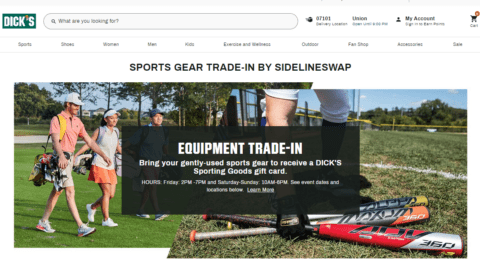Necessity forced the National Retail Federation Big Show from the physical world into the virtual one, but its reputation for insightful presentations from retail industry leaders drew a significant “crowd” despite the change of venue.
The six-day NRF 2021 Chapter One, which will wrap up on Jan. 22, has drawn a total of more than 20,000 attendees, representing approximately 3,500 companies, from 100+ countries. Approximately 30% of the attendees were located outside the U.S.
Chapter Two of the Big Show had originally been planned as an in-person event to take place in early June at New York City’s Javits Center, but the facility’s role as a COVID vaccination center made it unavailable, so it will also be a virtual event.
Following is just a small sampling of highlights from Chapter One’s 100 sessions.
Advertisement
Creature Comforts: Serving Consumers’ Desire for Life’s Simple Pleasures
In the first half of 2020, amid COVID’s first wave in the U.S., Chewy acquired more customers than it did in all of 2019. Chewy CEO Sumit Singh noted that these new customers will continue to come to the brand “with inquiries, demands and elevated expectations [for which] we’ll have to gear up to ensure we’re meeting [them] through our innovation and our great service.”
Effectively preparing for these new behaviors and expectations requires new ways of working and thinking, all of which came into focus for the broader Chewy business in 2020. During a fireside chat, Singh shared that the company focused on:
- Leadership: Chewy emphasized communicating frequently and honestly with employees. After employing work-from-home policies, the company has now decided to implement a hybrid work model that gives the workforce more control. By implementing internal programs and initiatives, Chewy leadership is helping forge internal connections that support communication and collaboration.
- Customer Experience: Chewy “innovated extensively” in order to adapt to consumer demand and broader market conditions. “We had to flex all our muscles,” Singh said. Although COVID immediately sparked a surge in online demand for the retailer, “that’s half the game,” he added. “You still have to execute upon demand and be able to service customers in a holistic, high-integrity manner.” At a foundational level, Chewy ensured that all employees, including service reps and those in warehouses, felt safe in their work environments. Then, Chewy doubled down on its ecommerce operations and inventory levels to ensure it could accommodate surges in traffic and demand.
- Product and Service Innovation: With pet parents sheltering in place, Chewy saw an opportunity to innovate. “Connect With a Vet” was rolled out as a new telehealth service that served consumers and veterinarians equally. Positioned as a “tele-triage platform,” the service was designed to connect pet parents to licensed vets when they had health questions or concerns. COVID propelled Chewy to launch a service that had been two years out on its internal road map, Singh noted, calling it an example of innovation “that capitalizes on opportunity created in ambiguity and chaos.”
How Walgreens Builds Community with Stores that are Ready for What’s Next
Like other essential retailers, Walgreens had to quickly make major adjustments to operate during the worst of the COVID pandemic — with the added burden of being a key provider of healthcare products and services. Robby Schwanz, Director, IT Field Services at Walgreens, sat down for a virtual chat with Fredrik Carlegren, VP of Global Marketing for Toshiba Global Commerce Solutions, to discuss how the retailer kept its fleet of more than 9,000 stores up and running during the pandemic to serve its customers’ changing needs.
Walgreens made numerous changes to its business model, including:
- Expanded grocery offerings;
- Free delivery and early refill authorization to prioritize continuity of care for its customers and access to their medications;
- Curbside pickup and expanded services via drive-thru (including COVID-19 testing);
- Partnering with DoorDash and Postmates for delivery; and
- The Village MD partnership to provide better access to healthcare.
Enhancing its omnichannel capabilities and expanding its loyalty program have been key areas of emphasis for Walgreens, with a focus on providing a personalized and differentiated experience. “It’s really important that we diversify the ways that we can reach people, but keep it a seamless experience,” said Schwanz. “We don’t want our customers to have a different experience online or in our app or in the store — it all needs to tie together. And it needs to be meaningful for that consumer.”
How e.l.f. Beauty Builds Lasting Customer Loyalty with Salesforce + Google
With a social following that spans nine million followers across key digital platforms like Snapchat, Pinterest, TikTok and Instagram, e.l.f. Beauty focuses on building an engaged, loyal community of customers. In fact, members of the e.l.f. Beauty loyalty program, Beauty Squad, make up 70% of the brand’s ecommerce sales, and they have a 117% higher lifetime value than non-members, according to Brigitte Barron, Director of CRM and Customer Growth at e.l.f. Beauty.
Using a combination of Salesforce Marketing Cloud and Google Analytics 360, Barron and her team are creating integrated campaign experiences that are tailored to consumer behaviors as a way to inspire them to sign up for the program.
Through a rigorous A/B testing process, e.l.f. Beauty strives to consistently improve all areas of the site experience. Visitors receive dynamic product recommendations based on what they’re browsing, can use the virtual try-on tool to validate purchase decisions and will receive relevant site pop-ups to register for the loyalty program if they have a high intent to buy. Once a purchase is made, consumers are brought through a nurture stream that features application tips and tricks and details on the Beauty Squad program.
Barron believes that the e.l.f. Beauty team is headed toward “creating one single customer journey…where we can see and control all of our consumer touch points across all our marketing channels,” she explained. “We want our lifecycle campaigns to encompass all marketing channels our customers interact with,” including paid search, paid social, push notifications and even offline channels like direct mail.
Luxury Goes Digital: Understand How Alibaba and Moschino Are Driving New Innovations
Like many luxury brands, Moschino had to pivot its marketing and commerce strategies to adapt to the realities of COVID. According to Stefano Secchi, Managing Director at Moschino, Tmall Luxury Pavilion became a crucial channel for the brand as it sought to successfully engage consumers in China, which accounts for more than 60% of the brand’s total presence in Asia. This market also represents a “new luxury consumer” base that is younger, excited to discover new brands and, of course, digitally native.
Innovation has “always been part of our DNA,” Secchi explained, but digital played a more central role in Moschino’s strategies throughout 2020. For example, Moschino expanded its relationship with Alibaba by joining the Tmall Luxury Pavilion, which allows brands to customize their digital shop experiences to feature their unique content, brand imagery and voice.
“Brands are fantastic at creating content, digital innovations and collections,” said Christina Fontana, Head of Fashion and Luxury, Tmall Luxury Division. “What we have done is create a platform that allows them to amplify their content and collections toward Chinese consumers.”
By participating in Alibaba’s 11.11 Global Shopping Festival, Moschino was able to test-drive livestreaming as a new shopping channel. However, this was only one of several investments Moschino made to move closer to customers online: the brand also experimented with digital showrooms and augmented reality (AR).
The Power of Vision to Reshape Retail and the Customer Experience
In separate fireside chats during NRF, Marvin Ellison, President and CEO of Lowe’s and Niraj Shah, Co-founder and CEO of Wayfair, revealed how they have reimagined their respective businesses to place the customer at the center of it all.
Ellison, a retail veteran with more than 30 years of experience, joined Lowe’s two years ago with a focus on going back to basics, concentrating on operational excellence and retail fundamentals as the means to grow the business.
“When I think about operational excellence in retail, it starts with a really stable and solid foundation,” Ellison said, emphasizing the importance of having core retail elements in place as the underpinnings for the rest of the organization’s framework. These include a robust labor management system, strong IT infrastructure, an ecommerce platform that provides agility and products that speak to customers from a value quality perspective.
Lowe’s also has stepped up both its commitment to its associates and engagement in communities, dedicating more than $1 billion in assistance that included offering free telemedicine benefits to all employees and bonuses to small business grant programs for diverse entrepreneurs.
As the company looks toward the future, Ellison said the retailer’s focus revolves around what is in the best interest of its customers. “It is really about being customer-centric and asking questions such as, What do we do as a company that will give the customer the ability to shop any way they choose? As we think about all the ways that customers desire to shop and all the ways that customers will probably shop in the future, that really dictates how we go to market internally and determines our capital span and our innovation strategy,” he explained. “And we now have a vision that we want to be able to provide a total home solution for a customer — that they can go to Lowe’s and they can get anything they need for their home.”
Also tapping into the home solutions market, ecommerce retailer Wayfair was founded 18 years ago, evolving in its first decade to establish 250 different websites covering various niches. That proliferation of sites ultimately led to the company’s 2011 launch and rebrand as Wayfair, providing one consolidated home experience online. While many view the brand as an ecommerce retailer, Wayfair considers itself more of a tech company — employing approximately 3,200 people (out of its 17,000 total workforce) who are software engineers, product managers, product designers or data scientists
“The combination of the internet, the global network and the advent of smartphones has really dramatically changed the way in which customers can engage and be serviced,” said Wayfair’s Shah. “Customer expectations have heightened. If you fully embrace technology and use it in transformative ways and embed it in all areas of your business, you end up doing brand-new things that you couldn’t otherwise do. And if you’re smart about understanding what customers want, you end up doing things that they really value and care about. [You] use the technology not for the sake of technology, but to create bespoke experiences that are in fact what customers desire.”
Embedding technology into every aspect of the business has been key to the company’s growth, along with an emphasis on providing great customer service — particularly for a category like furniture and home goods, where many items are bulky and easily damaged.
“If something goes wrong and then [customers] have a great service interaction, that only makes them want to come back more, because now they say, ‘Well, should anything happen, I know I’m going be taken care of very easily,’” said Shah. “That’s the kind of approach we take to continue to make the experience better and better, and that’s driving the growth.”
NRF 2021 Chapter One continues through Jan. 22, with sessions available on-demand for 30 days following.









